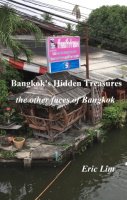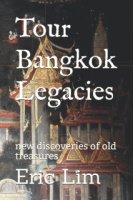- Home
- Bangkok Museums
- Patpong Museum
Patpong Museum – the dark secret
By Eric Lim
The Patpong Museum traces the origin of this well-known area famous for its raunchy bars, loud music and scantily dressed dancing girls. Not many visitors to the place would know that it also held a dark secret.
The museum was started by Michael Messner and opened in 2019 in Patpong 2.
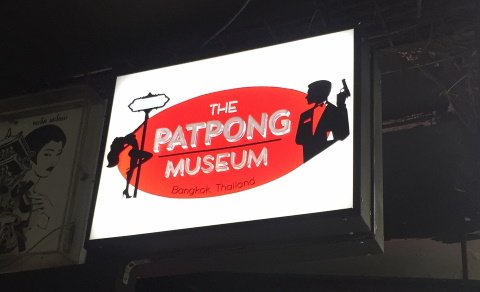
Patpong Museum
Let's trace the origins of Patpong which dates back to the late 1800's.
The Chinese Immigrant
In the late 1800s as China was crumbling in political turmoil and natural disasters, Chinese immigrants were leaving in droves to seek better lives for SE Asia. In 1893, a 12-year old boy from Hainan, Southern China arrived in Bangkok.
Like most Chinese immigrants to SE Asia in those days, Tun Poon started life in the care of a lady who was probably a relative or a good friend of the family. The lady, Mae Saeng Sathranon was in the rice trade and the boy learned the trade, lived a thrifty life, worked hard and soon became the manager of the business.
Tun Poon was 23 when Mae Saeng passed away and he decided to go into the rice trading business himself. Gradually his business expanded into rice mills, sawmills and ice factories. Tun Poon married in 1900 and had seven children.
The Siam Cement Group was established in 1913. Today it's the largest and oldest cement company in Thailand and South-east Asia.
When company opened a cement plant in Saraburi, Tun Poon had his lucky break. Farmers in Saraburi complained of a white substance in their fields which turned out to be calcium carbonate, an ingredient for making cement.
Tun Poon became the middleman for this product by selling the calcium carbonate to the Siam Cement Group and he prospered. He donated generously to public works, hospitals, schools and temples.
For his public service he was awarded the title of Luang and the royally bestowed name of Patpongpanich in 1927 by King Rama VII. He adopted Patpong as his family name.
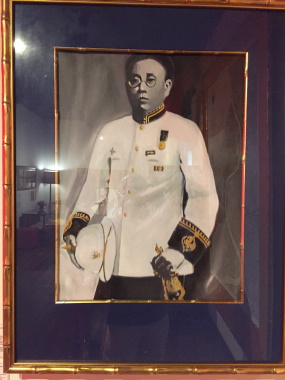
Luang Patpongpanich
In 1946 Luang Patpongpanich bought a plot of land between Silom Canal and Surawong Road for US$2,950 which included a large teak building that was to be the family home. The land was purchased at an auction from the pro-Japanese government who had confiscated the land from the Hong Kong and Shanghai Bank.
The teak building, incidentally, was the headquarters of the bank. Alas it is no longer standing today.
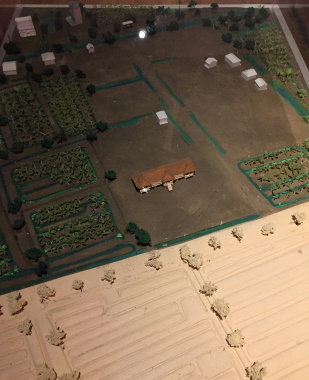
Model of the land and teak house Tun Poon bought, Surawong Road is at the bottom of the picture, Silom Canal is at the top
Luang Patpongpanich died in 1950 at the age of 69. The plot of land that he bought would give rise to the Patpong legacy.
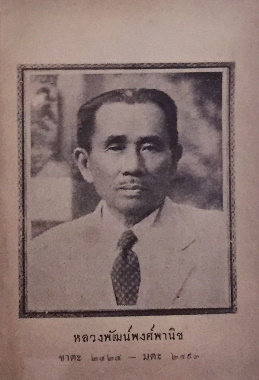
Luang Patpongpanich, born 1881 – died 1950
The Patpong Legacy
One of Luang Patpongpanich's sons Udom was studying in the London School of Economics in Britain when World War II broke out in Europe with the German invasion of Poland. He ordered Udom back to Thailand but with the introduction of conscription in Thailand, he packs Udom off to the USA to further his studies.
When World War II comes to South-east Asia, the Thai government joins Japan and declares war on the Allies. Udom joins the Seri Thai (Free Thai) movement an underground group resisting the Thai alliance with Japan. He undergoes airborne training with the OSS (Office of Strategic Services - forerunner of the CIA) in Georgia.
After training Udom was flown to Ceylon (Sri Lanka) to await an airborne insertion into Thailand. When the war ended abruptly in 1945, he returned to Thailand. He goes back to the States to continue with his studies and returns to Thailand a year later.
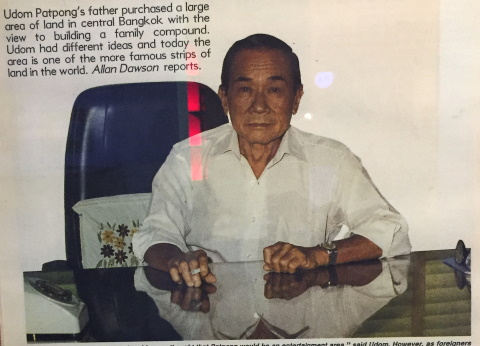
Udom Patpongpanich
Luang Patpongpanich was happy to see his son again and told him about the land that he bought. Before going for a holiday, Luang Patpongpanich asked Udom to cut a driveway along one side of the family home.
However, Udom had other ideas. With his education and exposure to the USA and the West, Udom saw the business potential of the family land.
Udom cut a 12-metre-wide road joining Surawong Road with Silom Canal instead. His father was furious when he returned but it was too late to reverse the decision.
What followed was the building of two rows of multi-storied buildings for commercial use. Soon his tenants included the offices of Air France, Caltex, Gestetner, IBM, Japan Airlines and Shell.
Restaurants and bars soon opened up to serve the people working here. In 1950 the first restaurant in Patpong, Mizu's Kitchen was started by a Japanese soldier who decided to settle down in Thailand. I recalled the delicious Japanese barbecue served on greasy wooden tables.
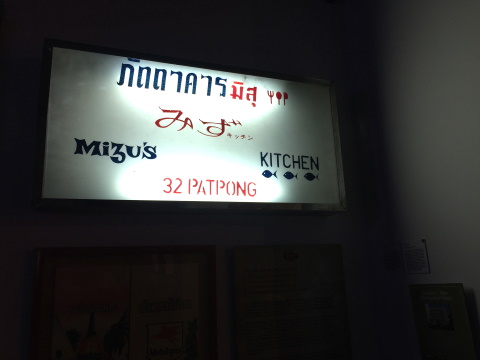
Mizu's Kitchen
Soon to follow came the Madrid Bar and Restaurant in 1969 which is still in business today serving mouth-watering pizzas, steaks, and hefty breakfasts of eggs, bacon, sausages and toast.
In the 1960s, Silom Canal was covered up to build Silom Road. This development was to have a major impact on the business potential in the area. Today Silom Road has one of the most expensive commercial properties in Bangkok.
In 1972 a second road, Patpong 2 was opened joining Surawong Road to Silom Road. The famous Patpong Night Market in Patpong 1 opened in 1991.
The Dark Secret
But Patpong wasn't all wine, women and song. What was not widely known was that back in the 1960s, Patpong had a secretive tenant that was conducting a secret and undeclared war in a neighbouring country right from Patpong.
In 1947, OSS the organisation that Udom joined during the war had become the CIA (Central Intelligence Agency). Udom's former OSS connections also brought in Western intelligence and secret services with their front companies operating under innocuous names like Air America and Civil Air Transport.
The CIA had their offices in the floors above the Madrid Bar and Restaurant in Patpong 1. According to a Patpong old-timer, Pat Landry the CIA Chief in Laos had an apartment on the top floor of the block. Today these floors are called the Madrid Apartments.
Air America had its office across the road from the Madrid. It was a four storey block half way along Patpong 1. The Patpong Dentist used to be in the same block.
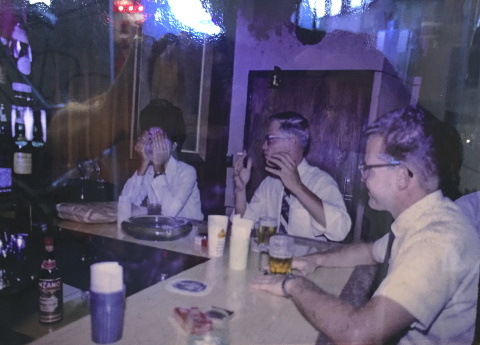
CIA staff drinking at the Madrid
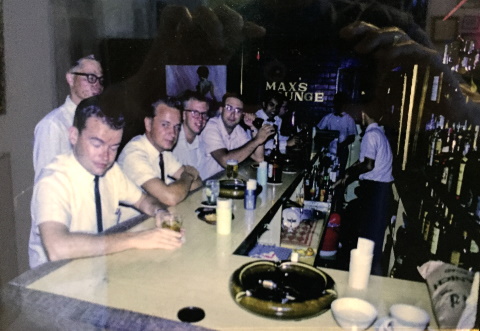
CIA staff at Max's Lounge – it was remarked that they looked more like evangelists
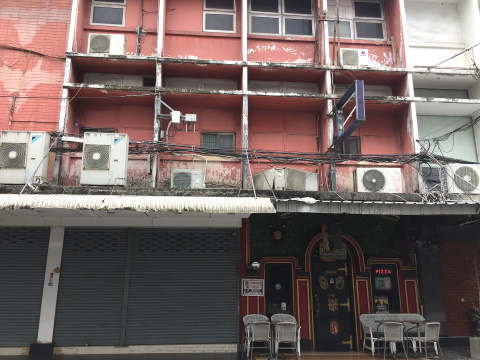
The Madrid Apartments today with the bar and restaurant on the ground floor
The Cold War
The end of World War II saw the beginning of a new conflict world-wide, the Cold War between the USA and her allies and the Communist bloc. Conflicts between these two adversaries were sprouting out all over Asia; Korea, Philippines, Vietnam, Laos, Cambodia and Thailand.
The Geneva Conference in 1954 after the fall of Dien Bien Phu resulted in the division of Vietnam at the 17th parallel into the Communist North and the non-Communist South. This was followed later by the Second Indochina War.
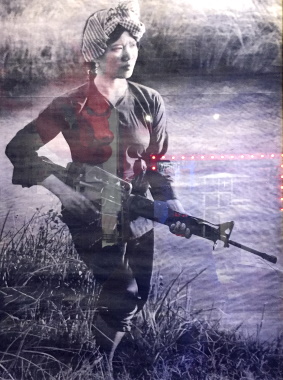
North Vietnamese woman fighter Lam Thi Dep aged 24, widowed twice, picture taken in 1972 by Vietnamese journalist Minh Truong
Laos and Cambodia got their independence as a result of this conference but North Vietnamese forces were using Laos as a supply route for their troops in South Vietnam. In Laos a civil war raged between the Communist Pathet Lao and the Royal Lao Government. This war dragged on from 1959 – 1975.
Tony Poe
One person who is prominently featured in the Patpong Museum is Tony Poe. Anthony Poshepny, better known as Tony Poe, was an ex-Marine who fought in Iwo Jima during World War II. He received two Purple Hearts during the war and was discharged as a sergeant.
He joined the CIA and took part in the Korean War training Korean refugees for sabotage missions behind communist lines. Later he joins the Overseas South-east Asia Supply (SEA Supply), a CIA front company operating in Patpong supplying equipment to Taiwan Nationalists in Burma. He was also responsible for training Tibetans to fight against Communist China.
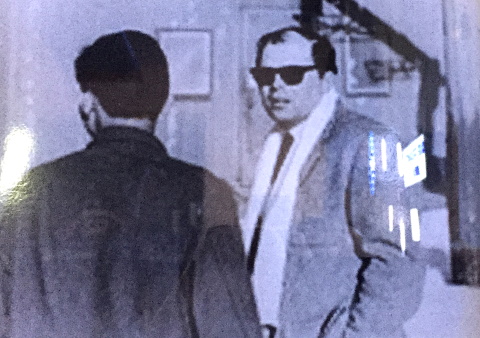
Poe in visiting the CIA office in Patpong, Bangkok during the 1960s
In 1969 when the Vietnam War and the civil war was in Laos was at its height, Poe was assigned to train and command Hmong tribesmen in their fight against the Communist Pathet Lao in Laos. He was one of the first CIA agents to be operating in Laos.
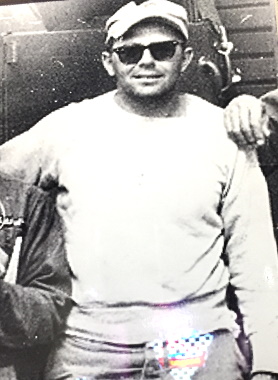
Poe taken while on a secret mission in Laos
Poe was a commander who personally led his troops into battle and inflicted the highest number of casualties on the enemy despite being injured several times. He was admired by his troops and described as efficient yet brutal in his methods.
When his number of kills for the enemy were doubted by the higher command, he ordered his men to cut off the ears of his victims and send them to his superiors! He was also reputed to have dropped off severed heads of the enemy into enemy territory.
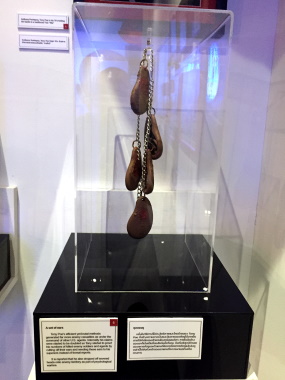
Replica of a chain of cut ears
During his service with the CIA, Poe received two Intelligence Stars equivalent to the military Silver Star. He was extracted from Laos in 1970, retired in 1974 and became a frequent visitor to Patpong.
Air America
When the Cold Wat started, the US government needed an air group to support these conflicts without having to go through the bureaucratic formalities of funding, approval etc. An organization fashioned after Claire Chenault's Flying Tigers which flew in support of China during WWII was the answer.
The Civil Air Transport (CAT) was started by Claire Chennault in 1946 to airlift supplies to China and support Chiang Kai Shek and the Kuomintang in the civil war with the Communists. Many of the pilots were from Chenault's Flying Tigers during World War II.
In 1950, the CIA bought over Civil Air Transport from Chenault and Mrs. Chiang Kai Shek who was also a shareholder and Air America was born.
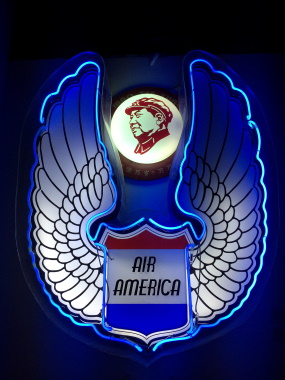
Air America
Though the name sounds like a commercial airline, this organisation was anything but commercial. The roles of Air America were:
· Aerial reconnaissance
· Search and rescue of pilots shot down over hostile territory
· Evacuation of refugees
· Insertion and extrication of armed groups into hostile territory
· Airlifting supplies to support friendly forces
The pilots, though ex-military personnel, had a civilian status and flew in unmarked planes. Sometimes, like in supply runs to the beleaguered French garrison in Dien Bien Phu, they flew planes repainted in French colours.
If they were shot down over hostile territory, they were on their own. The US government would not acknowledge their existence. They were paid $50 per landing in hostile territory or $50 per hour whichever is higher.
After the fall of Vietnam in 1975, Air America was closed down a year later in 1976. The pilots and ground support staff were discharged without any benefits or acknowledgment of their services to this day.
It was almost as if they never existed and whatever they did never took place.
On 31 July 2020, US Senators Marco Rubio (Republican, Florida) and Mark Warner (Democrat, Virginia) introduced the Air America Act of 2020 to allow ex-employees of Air America to be recognised as federal employees and be eligible for federal retirement benefits.
Israel 'Izzy' Freedman was a US Air Force pilot from 1960 – 1967. He left the Air Force and joined Air America in 1968 and flew in several missions over hostile territory. Izzy was one of the last few pilots to fly refugees fleeing Saigon as the North Vietnamese were closing in on the city in the fateful month of April 1975.
He was one of the pilots to land on the roof of the Pittman Apartments to take people scrambling up the ladder to the tower to board the helicopter. The photo below is that of another pilot landing on the Pittman Apartments.
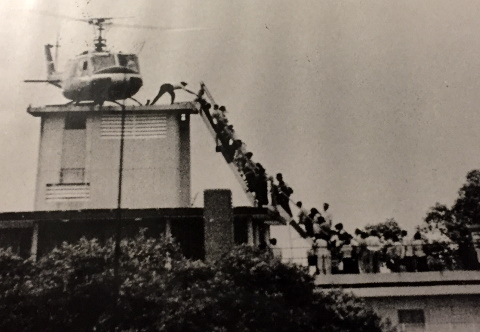
US chopper landing on Pittman's to evacuate foreign nationals
I asked Izzy if he knew Tony Poe and hit jackpot! Izzy flew several missions in support of Poe's operations in Laos. Next, I asked if all the information about Tony in the Patpong Museum were true. Without hesitation, Izzy said yes, he could even vouch for the cut ears but not the heads. He described Poe as, "foul-mouthed, hard drinking, unconventional and tough."
Izzy added that sometimes, Tony would say that he would send in the left ear then followed by the right, so as to increase the body count. I don't know whether to take that seriously or not.
Izzy left Air America in 1975 and settled in Thailand in 1976. In 1984 he started the Crown Royal, a cosy pub in Patpong 2. He's 83 today and happily retired in the country.
Some of the extra snippets of information on old Patpong are attributed to Izzy.
Scaled Model of Patpong
The centrepiece in the next room in the Patpong Museum is a scaled model of the two streets in Patpong, Patpong 1 and Patpong 2 as viewed from Surawong Road towards Silom Road.
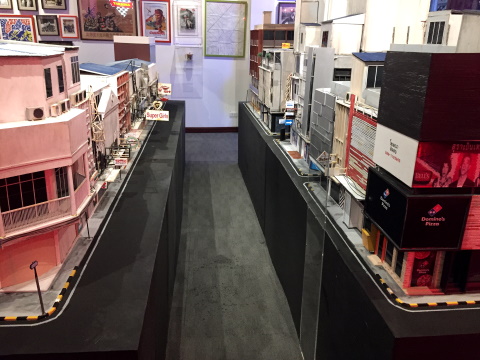
Patpong 1 – the Air America building is the pink building to the left of the picture
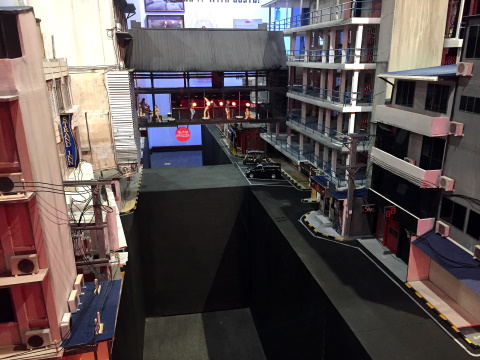
Patpong 2, the Black Pagoda is located in the overhead bridge, the Patpong Museum is just to the right, IBM used to occupy the museum premises
The First Go-Go Bar in Patpong
To those unfamiliar with Patpong, there are basically four categories of bars here.
1. Go-go bars
2. Sex show bars
3. Pubs
4. Bar and restaurants
The last two categories are self-explanatory; the first two will be described in the following sections. There's a fifth category but that's not within the scope of this article.
Go-go bars are where scantily clad dancing girls perform animated dances on bar tops. These bars may be L-shaped, U-shaped or oval; customers sit around the bar to ogle at the girls. Others prefer to sit at tables further away from the stage.
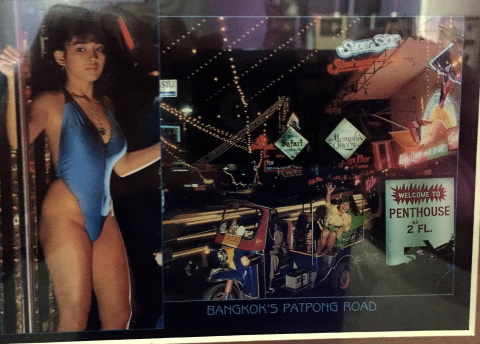
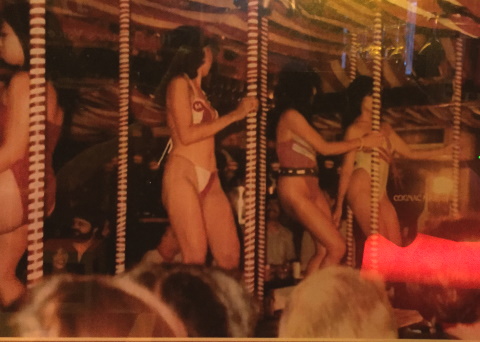
Go-go dancers
The term "go-go" is believed to be derived from the French word "a gogo" meaning a lot or in abundance; an apt description in view of the amount of energy expended.
In course of the vigorous performances, some of the performers may lose parts of their costumes. Another feature of the go-go bars are the vertical poles on the bar tops where incredible leg stretches and spins are executed.
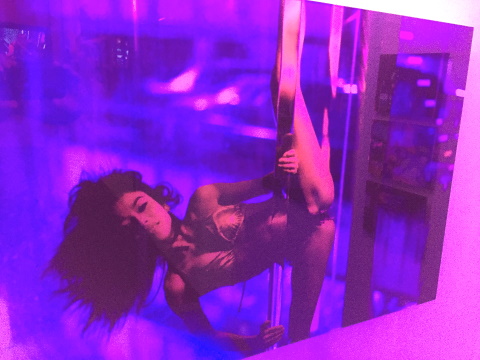
Pole dancer at the Black Pagoda
The opening of the first go-go bar in Patpong must surely be a landmark event in the history of the place. In 1969, Rick Menard, formerly of the US Air Force, opened the Grand Prix Bar, the first go-go bar in Patpong.
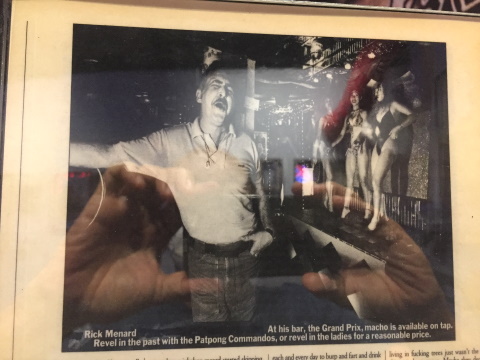
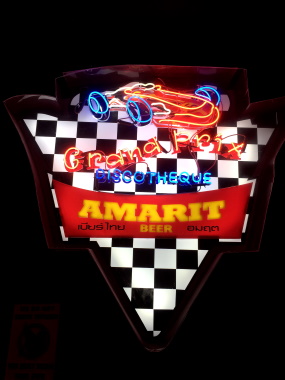
Rick Menard and the Grand Prix
The Movie Wall
As Patpong gained international renown, many movie makers shot some of their movie scenes in Patpong. In 1978 a scene from Deer Hunter was shot in the go-go bar, Mississippi Queen in Patpong 1. However, the signs in Thai were all covered up and replaced with Vietnamese to simulate a bar scene in Saigon.
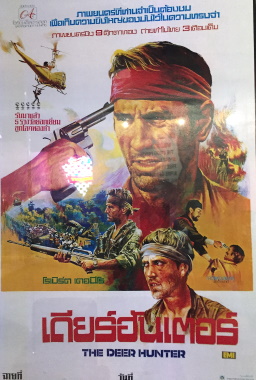
Deer Hunter
The Deer Hunter will be remembered for that deadly game of Russian Roulette.
Kick Boxer, an American martial arts movie shot in 1989, featured Jean-Claude van Damme in the opening sequence stepping out of a tuk tuk in front of the Superstar Go-Go Bar in Patpong 1.
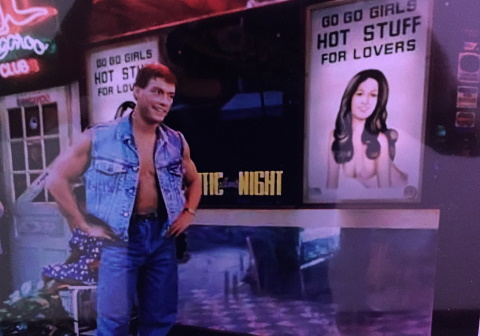
Jean-Claude van Damme appearing in Patpong in Kick Boxer
David Bowie in Patpong
Another celebrity who made an appearance in Patpong was David Bowie who shot his musical video Ricochet in the Superstar Go-Go Bar in 1983 before he gave his concert in Bangkok.
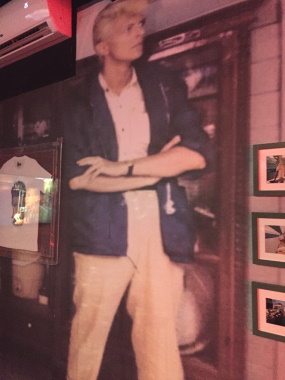
David Bowie in Patpong
The Wall of Fame
The Wall of Fame in the Patpong Museum is a high-tech display featuring well-known people who have visited Patpong. But you can't see the photos as the display screen is blank. To view the photos, use the mobile device attached to the wall, turn it on and scan the blank screen. The name and photo of the person will appear on the mobile device.
Patpong Bar
The bar in the Patpong Museum is fully stocked, I assumed it's all genuine. As it was in the middle of the day and I don't usually have my first drink before sundown, I couldn't find out.
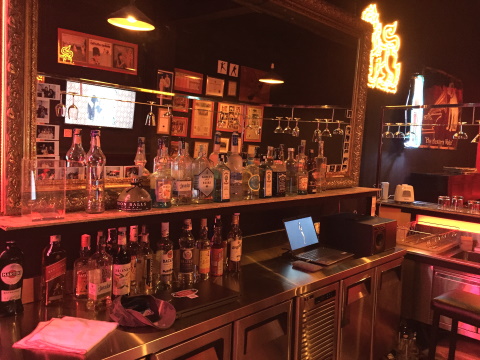
Well-stocked bar in the Patpong Museum
The walls of the bar area are plastered with copies of articles on Patpong, an indication of how well covered the area was over the years.
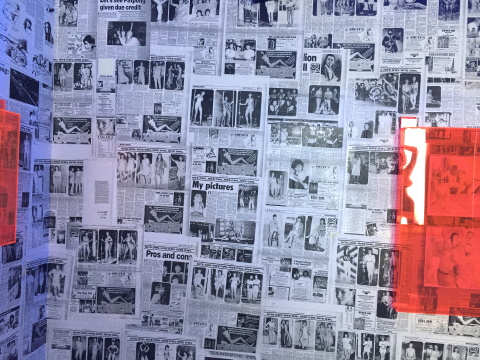
Press coverage of Patpong
There's another high-tech display wall near the bar and this consists of a series of photos of beautiful girls. Your job is to guess whether they are real girls or the so-called "ladyboys". After you have guessed, lift the lid on the photo to find out the answer.
Make a guess first. Don't cheat!
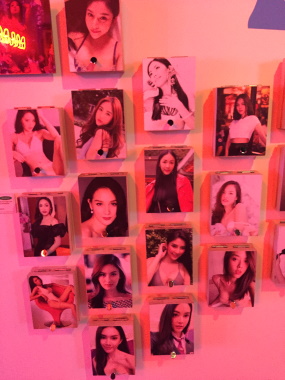
Lady or ladyboy?
Game of Ping Pong?
The infamous ping-pong show is featured in the sex show bars. Here, female performers in the nude project ping pong balls from their genitals at the customers. Some customers are crazy enough to try catch these balls, others desperately try to avoid them.
Besides ping pong balls, other items are used as well. If you don't fancy such acts, give these bars a miss.
In the Patpong Museum, the ping pong show is simulated using a ping pong ball launcher used to train table tennis players. The projector is placed at the pubic area of an image of a nude woman with her legs spread wide apart.
If you like, the museum staff will activate the launcher and let you catch the ball. As I wasn't good at table tennis, I passed.
Fetish Corner
The Fetish Corner is screened off by a curtain of chain links. Behind this screen is a wicker basket suspended from the ceiling. It's big enough to fit a human being. I didn't venture to ask for details.
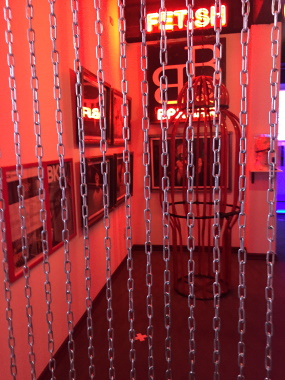
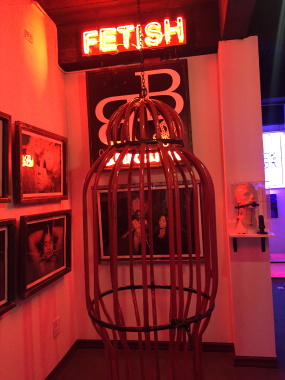
Fetish Corner in the Patpong Museum
Erotic Art
The last section of the Patpong Museum is a little easier on the senses. The beautiful water colours here depict nudes and nudes in erotic postures.
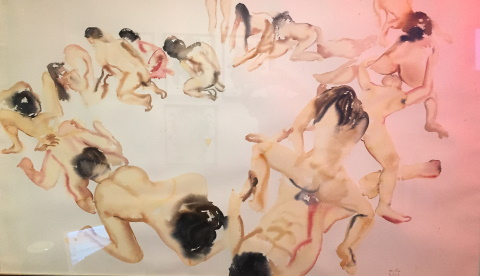
Erotic art
End your tour of the Patpong Museum with a coffee at the cosy café near the exit.
Patpong today
I visited the Patpong Museum in early August 2020 when many F & B outlets in Patpong were still reeling from the aftermath of the severe lock down because of the Covid 19 pandemic. From March – May 2020, all F & B outlets were closed for sit down customers; only takeaways were allowed.
Mizu, the grand old man of Patpong, was one of the first to call it a day. The Patpong Museum managed to salvage the signboard to be put on display in the museum.
Vinai's Cosmos Bar was the next to go. I met Khun Vinai as I was walking along Patpong 2 viewing some of the old buildings after visiting the Patpong Museum. Poor business just couldn't cover the expenses. He has opened a small beer bar along Patpong 2 closer to Surawong Road.
Cosmos was the favourite watering hole of an old friend who would be at the bar from after lunch till after sundown. He is now in the big watering hole up in the sky and wouldn't miss the closure of Cosmos.
At Jenny's Madrid, it's business as usual. I had a hearty breakfast of fried eggs, bacon, sausages, fried onions, potatoes and toast while waiting for the museum to open.
For those outlets that are no longer operating in Patpong and the Patpong regulars who are no longer with us, the Patpong Museum preserves the memories.
My Thanks
My thanks to Randall Howlett for the conducted tour of the Patpong Museum. Khun Kriengsak Khasrithong, a museum staff member, who was formerly a logistician in the US Air Force also had some interesting stories to share.
Last but not least my thanks to Israel "Izzy" Freedman for sharing his insights on early Patpong and his experiences with Air America. I sincerely hope the Air America Act 2020 passes through Congress so that he and his colleagues will get the benefits they so richly deserve.
All photos are with the courtesy of the Patpong Museum except the photo of the helicopter landing on the Pittman Apartments in Saigon.
That memorable photo is with the courtesy of Israel "Izzy" Freedman.
Map to the Patpong Museum
Or click on this link to view the map to the Patpong Museum
Address:
Patpong Museum
No. 5 Patpong Soi 2
Bangrak,
Bangkok 10500
Thailand
Tel: +66 (91) 8867 829
Tel: +66 (91) 8867 829
Tel: +66 (91) 8867 829
Facebook: https://www.facebook.com/patpongmuseum/
Web site: www.patpongmuseum.com
How to get the Patpong Museum
The easiest way to get there is to take the Green Line (BTS Sky Train Silom Line) to the S2 Sala Daeng Station and then walk to Patpong Soi 2.
Or if the BTS isn't available where you live, take the MRT (subway) to Silom Station (SIL). It's a slightly longer walk.
If you are coming in from Silom Road, the Patpong Museum is on your left opposite Foodland Supermarket. It's on the second floor near the Black Pagoda.
Opening times
The Patpong Museum is open every day from 1100 – 2100 hours from Sundays to Thursday and 1100 – 2200 hours on Fridays and Saturdays.
Admission:
Adults over 18 only - 350 baht per person which includes one drink.
For more Bangkok Museums.
My Journey through Thailand Part I The First Steps
This is my second e-book and the first in the series of travel journals on my trips to explore the various provinces in Thailand. This edition, which covers my travels from late 2009 to mid-2013, will guide you to historical sites, cultural monuments and exquisite Thai handicraft, across a vast spectrum of cultural and ethnic diversity.
You can have a virtual tour with this e-guide book or take the first steps yourself in this journey through Thailand.
My Kindle e-book






